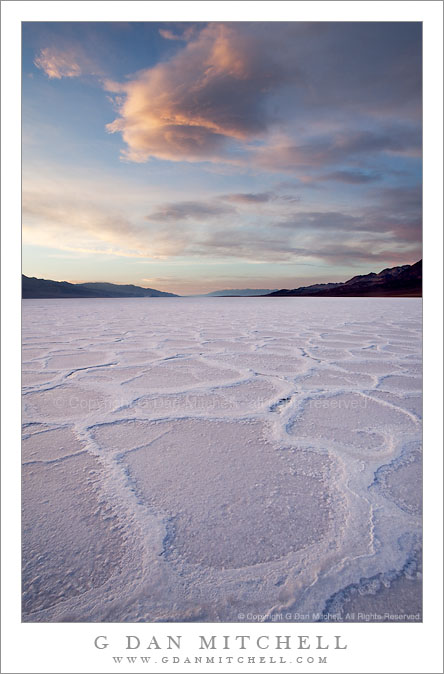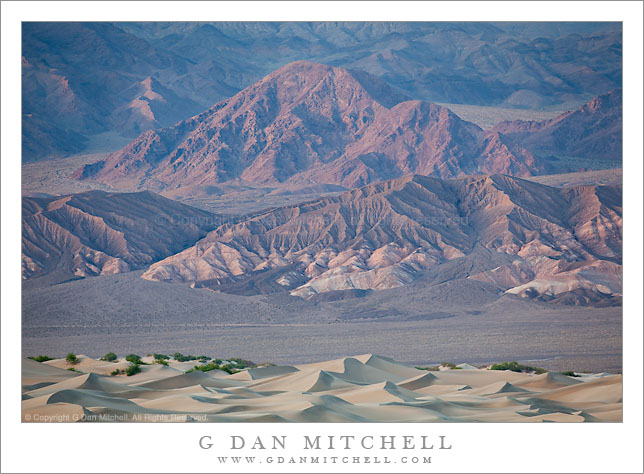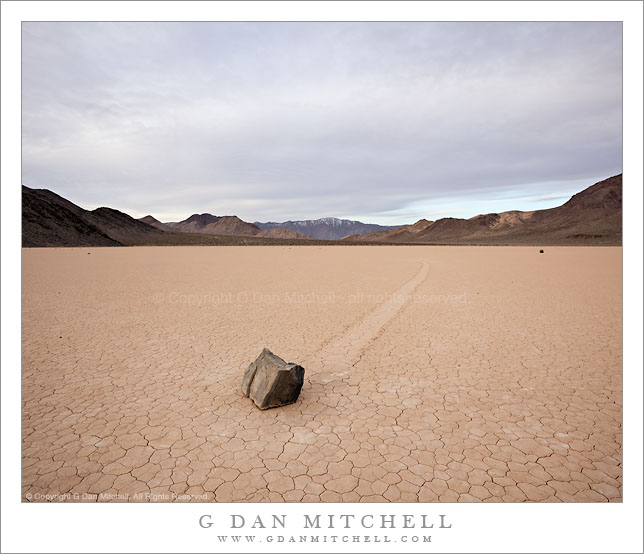Salt Flats and Sunset Clouds – Near Badwater. Death Valley National Park, California. March 29, 2010. © Copyright G Dan Mitchell – all rights reserved.
Sunset clouds above the patterned salt flats near Badwater, Death Valley National Park, California.
This photograph was made in the evening at the “secret” spot on the salt flats just south of Badwater. Reports and photographs from this location a couple weeks ago indicated that it had been flooded by earlier heavy rains, but by the time of my visit there was little standing water left here, with the exception of a few open spots (one seen in the middle distance on the salt flats) – though it did appear that the flats might still be wet beneath the salt crust. Walking on this was an odd experience that reminded me a bit of walking on newly frozen winter ice. The appearance of the salt flats was quite changed by the water. Typically the ridges between the flat “polygon” sections of the salt are more distinct, being as tall as a few inches and sometimes almost seeing to break over one another like the edges of ice floes. But at this stage the flats are almost, well, flat.
Shooting this scene in the evening often provides a few technical challenges. In the past I’ve shot from a lower camera position in order to get a closer view of the salt. This time I decided to place the camera bit higher so that I could capture a larger expanse of the salt flat texture. Another issue is the color of the salt. We “know” that salt is white, and when one walks on the playa it registers as white to the eyes/mind. But if you observe carefully – or look at a photograph later – you find out that this salt is anything but white, mostly because it is illuminated entirely by the open sky and therefore picks up the sky coloration. When the sky is clear the salt can become so blue that corrections are needed, in my opinion, during post-processing. On this evening the blue was not as pronounced since the colorful clouds balanced it out to some extent. A third issue is the tremendous dynamic range of the scene, ranging from some very bright sky below the clouds near the left side of the frame, through the much less brightly-lit salt flat, to the very dark foothills on the horizon at the right. In order to manage this I had to do two things. First, instead of using a graduated neutral density filter to lighten the foreground and control sky brightness, I made two exposures one stop apart and combined them in post. Secondly, I used layers to separately adjust sections of the image, primarily differentiating between the salt (which need to be lightened up a bit) and the sky (where the brightest areas needed to be controlled).
This photograph is not in the public domain and may not be used on websites, blogs, or in other media without advance permission from G Dan Mitchell.
G Dan Mitchell Photography | Twitter | Friendfeed | Facebook | Facebook Fan Page | Email
Technical Data:
Canon EOS 5D Mark II
Canon EF 17-40mm f/4 L at 17mm
ISO 100, f/16, composite: 1/6 second and 0.3 second
keywords: badwater, salt, flats, polygon, pattern, playa, death valley, national, park, california, usa, north america, evening, dusk, sunset, cloud, colorful, pink, orange, blue, sky, landscape, nature, light, travel, scenic, geology, mountains, stock




